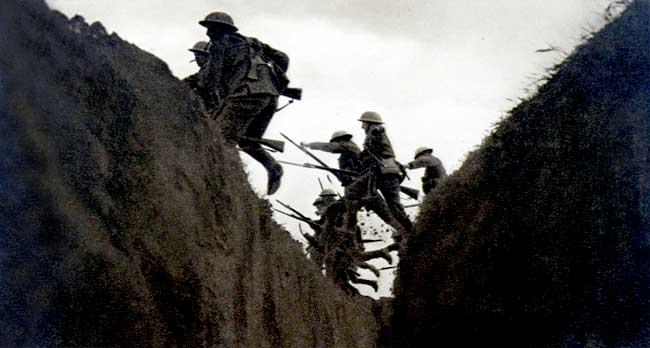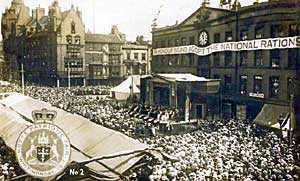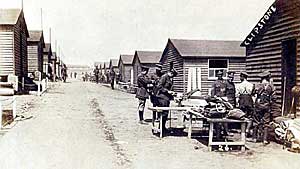

The Great War in Nottingham
Chronology of World War One
- June 28th 1914. Gavrilo Princip assassinates Arch Duke Franz Ferdinand at Sarajevo and triggers off a chain of events embroiling much of Europe in conflict
- August 4th 1914. Britain declares war on Germany after Belgian neutrality is violated
- May 7th 1915. Cunard liner Lusitania is torpedoed off the Irish coast
- February 21st 1916. Battle of Verdun begins
- 31st May 1916. Jutland sea battle
- July-November 1916. Battle of the Somme
- February 1st 1917. Germany begins unrestricted submarine warfare
- April 6th 1917. America declares war on Germany
- July-November 1917. 3rd Battle of Ypres usually referred to as Passchendaele
- March 3rd 1918. Treaty of Brest Litovsk takes Russia out of the war.
- March 23rd 1918. Ludendorff’s final attempt at outright victory is launched on the Western Front
- November 11th 1918. The war ends as German forces surrender
Few people in Nottingham predicted that Gavrilo Princip’s assassination of Arch Duke Franz Ferdinand and Sophie Duchess of Hohenberg at Sarajevo on June 28th 1914 would spark a chain of events catapulting Europe into full scale war within six weeks. Even during the final days of peace, Nottingham’s rival Express and Guardian publishing houses still cherished the idea that in Germany, just as in England, the mass of the people were kindly and pacific, Kaiser Wilhelm inclined to reason and war between civilised countries unthinkable. Common sense and British foreign secretary Sir Edward Grey’s determined mediation would disperse gathering storm clouds. However, as the month turned with Berlin ignoring all attempts to broker compromise, so did the local mood; “With the deadly mechanical certainty of its stupendous military arrangement,” the Nottingham Evening Post grimly noted on August 1st, “Europe is marching into a state of war.” A matter of hours later, troops from seven German armies invaded Belgium a violation of neutrality which, by international treaty, demanded Britain’s declaration of war. Europe’s lethally binding network of alliances rapidly ignited a conflagration that would kill sixteen and a half million people from across the globe and embroil the citizens of Nottingham in the most devastating conflict in British history.
War may have seemed a remote prospect in Nottingham at the end of June but its declaration on August 4th provoked a wave of patriotic celebration in the city. An exuberant crowd greeted the mobilising Robin Hood Rifles (1/7th Sherwood Foresters) at Victoria Station on August 2nd and, eight days later, streets from the Market Square to Canning Circus were lined ten deep as the same battalion marched off to the Front. By this time, the city’s response to Lord Kitchener’s call to arms was well under way. Nottingham’s enthusiasm for military service was most evident in August and particularly September 1914; by August 18th, 600 men had volunteered, September 1st saw 134 men enlisting and on September 10th, a record 500 joined the colours in the city but, from the middle of the month, there followed a rapid slow down followed by a dramatic slump in October.
Thereafter, although the rate recovered, it fluctuated as the war lost popularity amidst rising casualty figures. Nearly 200 men enlisted during the week ending November 30th and 1,125 volunteered during December and over 1,500 in January 1915. Recruiting dipped in early 1915, spiked briefly in May following the Lusitania disaster but again declined through the summer amidst depressing news from overseas. The threat of conscription gave some impetus to local recruitment in August, October and November but most Nottinghamians realised that Britain was heading inexorably towards compulsory military service. Before conscription was finally announced by Asquith in January 1916, 24,229 men from Nottingham (out of a national total of 2.4 million) had enlisted voluntarily for service with the British Army, 18,527 for New Army units and 5,702 for Territorial battalions.
Conscription had a slow launch in Nottingham (as elsewhere) because 15,691 of the local unwilling immediately appealed. Their appearances before Military Tribunals, which invariably rejected claims for exemption on conscientious grounds but often ruled leniently in cases involving family support, hardship or ill health, were defiant, farcical, tragic and pathetic in about equal measure and, provided excellent voyeuristic entertainment, “far more enthralling,” as the Beeston Gazette put it “than the police courts in providing piquant glimpses into other peoples’ lives.” Although conscription remained a divisive issue in Great War Nottingham, most local people endorsed compulsion and around 25,000 men from the city were eventually called up.
5,370 men from Nottingham lost their lives as a result of Great War combat. The number seriously wounded must remain conjectural but in 1921 the city’s General Hospital was still treating 18,400 disabled servicemen. No complete list of Nottingham’s Great War dead has ever been compiled but, from national data, it can probably be extrapolated that only 1% (around 50) of the city’s fatalities were airmen, 6% (about 320) sailors whilst a massive 93% (over 5,000) served in the army. It is almost certain that four fifths of this group were killed in France and Flanders, around 4% held commissions and that two thirds were aged under 30. Carnage on the Western Front devastated communities across the city of Nottingham (see map). Not surprisingly losses were greatest in more populous areas such as the Meadows, St. Ann’s and Radford but the most dreadful price for the loyalty of its young men was paid by the much smaller parish of Lenton.
Previous wars had been fought by Britain’s professional armed services with little impact on the general populace. The 1914-18 conflict, by contrast, was a peoples’ war involving the masses not only as soldiers in vast new armies but on the Home Front as active, supportive participants and, on occasions, victims. It would be difficult to exaggerate the contributions to victory of Britain’s women. Nottingham’s hosiery industry was transformed as a consequence of the war. Within weeks of its outbreak, enormous orders from the War Office for socks, underwear, pullovers, balaclavas and gloves had been placed. By May 1915, at least a quarter of the city’s hosiery machinery was employed on government contracts. Demand could only be met by allowing women to fill roles in hosiery factories previously reserved for men. The substitution of women for men in Nottingham’s industries was supervised by a local sub-committee of the National Advisory Committee upon Women’s War Employment which helped local firms support the war effort by using large numbers of women workers. At Raleigh, the machinery for making Sturmey-Archer gears proved ideally suited for making fuses and the giant presses used for sheet steel parts was converted to the manufacture of Lewis gun magazines. Raleigh’s work force expanded from 2,000 in late 1915 to 5,000 by the end on 1918 and most of the additional workers were female. At Boots, 900 workers, mainly girls, were producing 90,000 gas respirators per week by April 1918 under an arduous three shift, 53 hours a week system. Thousands of women, three quarters of them reported to be wives or mothers of serving soldiers, produced munitions in Nottingham’s Meadows gun factory and on a 260 acre site at Chilwell where, on July 1st 1918, 134 workers were killed and 250 injured by a massive explosion. In December 1918, it was estimated that 35,000 women were employed on war contracts in Nottingham. Many others became window cleaners, nurses and entered commerce, the banks and office work of all types. The Post Office employed Nottingham women on both deliveries and sorting and 62 women became tram conductors in the city.

The Notts Patriotic Fair in 1917.
Nottingham’s predominantly female teaching force not only battled to maintain an education service under severe stress through staff shortages and under-funding but also strove to feed and clothe the city’s poorest families and made vital contributions to 1915’s recruiting drives by canvassing the National Register on August 15th and by helping to implement and administer Lord Derby’s Scheme in the autumn of that year. Schools in Nottingham helped sustain morale and unity amongst neighbourhoods facing adversity, separation and bereavement. Rolls of Honour were compiled and old boys in military service lionised, paraded and eulogised in rituals, often attended by parents, clergymen and councillors, which maintained connections between school communities and the armed forces and bolstered support for the war effort. Schools used annual Empire Day festivities, Shakespeare’s tercentenary in 1916 and the Nottingham’s Patriotic Fair a year later to further solidify patriotic resolve.
The Great War had profound consequences for civilians in Nottingham. Most children remained outwardly cheerful and accepted privations as part of their patriotic duty. Many probably enjoyed half time schooling, regarded allotment work as an agreeable change from classroom routine and even found filling sandbags, at least initially, diverting. However, around 2,500 children from the city lost fathers during the conflict with many thousands more left grieving for brothers and other relatives. Children would venerate fallen fathers for the rest of their days but Great War home life often entailed helping grief-stricken mothers in a daily struggle for existence in an era when the repression rather than discussion of personal feelings was encouraged. In some cases, children had to cope with issues of post war readjustment as families sought to re-assimilate demobilising servicemen after long periods of absence. Even Great War veterans who had escaped physical or psychological damage often experienced degrees of disorientation, depression, resentment, jealousy and disillusionment with a “land fit for heroes”.
Zeppelin raids turned terrified civilians into combatants in their own homes. Although Nottingham was attacked only once, in September 1916, many young people in the city were discomfited and some traumatised by the experience. “Attendance this week has been severely affected by the Zeppelin’s visit the other night,” recorded one Meadows head teacher, “many children unable to sleep and too tired as a consequence to come to school.” Unrestricted U boat attacks caused food shortages especially during 1917. People in Nottingham did not starve but, until the introduction of rationing early in 1918, some went hungry and many more were involved in the daily scramble for food. As one Basford head teacher noted in February 1918, before distribution of essentials was fully controlled, “The attendance of the children is being seriously affected by the queue system even among the little ones who have to stay at home minding the baby whilst mother goes out in search of food.” The 1918-19 influenza epidemic killed 1,396 people in Nottingham, 884 of them during November 1918 at the height of the disease’s second wave during which the city became the second most afflicted borough in Great Britain. All schools in Nottingham were closed for three weeks and soldiers employed as emergency grave diggers before the outbreak abated.
As the killing finally stopped, newspapers in Nottingham were anxious to convey a sense of overwhelming, widespread relief and rejoicing at the cessation of hostilities; The “nightmare horror of the past four years has at last dissolved into a glorious victory,” noted the Evening Post, which reported “unbounded joy” and the “greater part of the city ablaze with bunting”. According to the Evening News, “the scenes in the Market Place baffled description. On all sides one heard but one word – ‘Peace’. Yet, despite the flags and cheering crowds bolstered by excited youths and munitions girls, it is clear that many Nottinghamians felt no inclination to party on November 11th, 1918.
Four years of bitter and tragic conflict had induced a profound shift in the mood of many citizens. The euphoria of late summer 1914, had long since evaporated; groups of women assembled in working class districts across Nottingham on that first Armistice Day but their mood was sombre and reflective rather than exultant. A local paper which, on September 2nd 1914 had reported “young men flocking to the Colours in hundreds” and “stirring recruiting scenes” now acknowledged that “bereavements caused by the war have been so terrible that, great as is the relief experienced at its termination, the public are not likely to give way to unrestrained merriment.” The “war to end all wars” had taken an appalling toll on the city of Nottingham.
The Great War in Nottinghamshire (by Andy Nicholson)
Inhabitants of the county shared similar experiences to people living in Nottingham: the pain of losing their young men in growing numbers as the war progressed; food and fuel shortages with rationing introduced in February 1918; the opening up of a wider range of occupations to female workers (e.g munitions work, transport and agriculture) and the hastening of the collapse of traditional women's employment such as domestic service.
Zeppelin raids were focussed on Nottingham and so the county escaped very lightly. However, in September 1916 an airship was blown off course and bombed the town of Retford, mistakenly believing it to be Nottingham. The gasworks were hit and a number of neighbouring houses damaged.

Clipstone camp.
The largest military presence was at Clipstone Camp, established on the eastern outskirts of Mansfield in December 1914. The first troops to arrive were the University and Public School Regiment in May 1915 and it has been estimated that 20,000-30,000 men passed through the camp before it closed in 1919. The camp was served by a railway station with regular services to Mansfield and a church for 900 worshippers was built in April 1916. Mansfield became a ‘garrison town’ and benefitted economically from the large numbers of service personnel on its doorstep.
Internment camps were also established. At the Midland Agricultural and Dairy College in Sutton Bonington, newly constructed buildings were commandeered in 1915 to hold German officers; the most famous internee was Karl von Muller, captain of the Emden light cruiser.